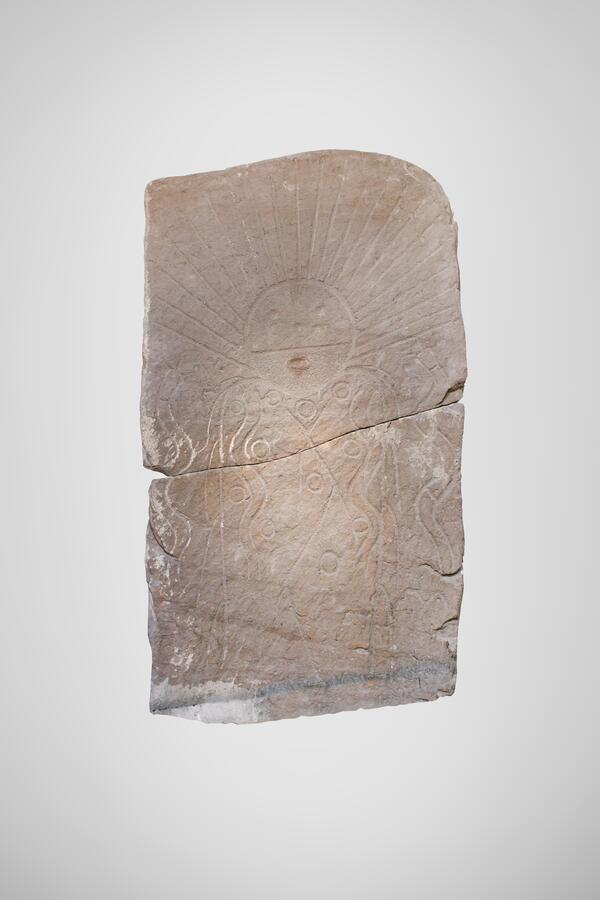The stela with the image of a sun-faced deity was found during excavations of the Tagar mound near the aal (settlement, camp) of Ankhakov of the Askiz district of Khakassia. The mound was erected approximately in the 8th-2nd century BC. The stone slab presented was part of its fence. Archaeologist and historian Albert Lipsky brought it to the Khakass Museum of Local History in 1954.
In the upper part of the stela, a sun with human features is depicted, divided into two parts by a horizontal line. The surface of the face downward from this line is engraved along the entire plane with a small dot pattern. It is schematically outlined in straight vertical lines, 22 long beams with dots at the ends diverge to the sides. On the body or clothing of the deity, circles with dots in the center are embossed — symbols of eternal fertility.
Many peoples of Siberia worshiped the sun as the Great mother. Archaeological research indicates that the ancestors of the Khakass people built temple complexes dedicated to heavenly bodies on the territory of the Khakass-Minusinsk depression. The sun was considered the creator of all living things, a protector, guarding people, especially children and women. The image of the sun was associated with the feminine principle, it symbolized fertility and wealth. During various rituals, they moved “with the sun”, that is, clockwise. They prayed to the gods, always facing the sun.
The Khakass believed that the higher powers send the woman the soul of the unborn child in the form of a ray. It was believed that it passes through the smoke hole of the yurt and into the woman’s body. Therefore, in the Khakass tradition, the matrimonial bed was placed in the yurt in such a way that the sun’s rays fell on it.
Besides the sun, the statue depicts four wriggling snakes — they are embossed on the sides of the stela. In the mythology of many Siberian peoples, snakes personify the Lower World. It was them that the ribbons on the shaman’s costume symbolized. It was believed that in the image of a snake, he could penetrate into the world of evil spirits.
The Khakass people associated the image of a snake coiled into a ring with the cyclical nature of natural phenomena — the change of day and night, seasons. In the Khakass language, the words “year” (chyl) and “snake” (chylan) have the same root.
In the upper part of the stela, a sun with human features is depicted, divided into two parts by a horizontal line. The surface of the face downward from this line is engraved along the entire plane with a small dot pattern. It is schematically outlined in straight vertical lines, 22 long beams with dots at the ends diverge to the sides. On the body or clothing of the deity, circles with dots in the center are embossed — symbols of eternal fertility.
Many peoples of Siberia worshiped the sun as the Great mother. Archaeological research indicates that the ancestors of the Khakass people built temple complexes dedicated to heavenly bodies on the territory of the Khakass-Minusinsk depression. The sun was considered the creator of all living things, a protector, guarding people, especially children and women. The image of the sun was associated with the feminine principle, it symbolized fertility and wealth. During various rituals, they moved “with the sun”, that is, clockwise. They prayed to the gods, always facing the sun.
The Khakass believed that the higher powers send the woman the soul of the unborn child in the form of a ray. It was believed that it passes through the smoke hole of the yurt and into the woman’s body. Therefore, in the Khakass tradition, the matrimonial bed was placed in the yurt in such a way that the sun’s rays fell on it.
Besides the sun, the statue depicts four wriggling snakes — they are embossed on the sides of the stela. In the mythology of many Siberian peoples, snakes personify the Lower World. It was them that the ribbons on the shaman’s costume symbolized. It was believed that in the image of a snake, he could penetrate into the world of evil spirits.
The Khakass people associated the image of a snake coiled into a ring with the cyclical nature of natural phenomena — the change of day and night, seasons. In the Khakass language, the words “year” (chyl) and “snake” (chylan) have the same root.



